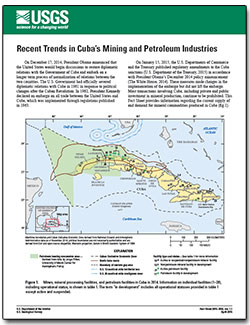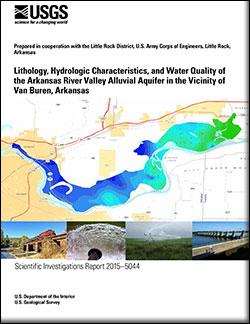Filters: partyWithName: U.S. Geological Survey (X) > Types: Citation (X) > Types: OGC WMS Service (X) > Categories: Publication (X)
30 results (31ms)|
Filters
Date Range
Extensions Types
Contacts
Categories Tag Types
|
Amphibians and reptiles (herpetofauna) have been linked to specific microhabitat characteristics, microclimates, and water resources in riparian forests. Our objective was to relate variation in herpetofauna abundance to changes in habitat caused by a beetle used for Tamarix biocontrol (Diorhabda carinulata; Coleoptera: Chrysomelidae) and riparian restoration. During 2013 and 2014, we measured vegetation and monitored herpetofauna via trapping and visual encounter surveys (VES) at locations affected by biocontrol along the Virgin River in the Mojave Desert of the southwestern United States. Twenty-one sites were divided into four riparian stand types based on density and percent cover of dominant trees (Tamarix,...
Categories: Data,
Publication;
Types: Citation,
Map Service,
OGC WFS Layer,
OGC WMS Layer,
OGC WMS Service;
Tags: 2012,
AZ-01,
AZ-02,
AZ-03,
AZ-04,

Categories: Publication;
Types: Citation,
Map Service,
OGC WFS Layer,
OGC WMS Layer,
OGC WMS Service;
Tags: Fact Sheet
An important unresolved question is how populations of coldwater-dependent fishes will respond to rapidly warming water temperatures. For example, the culturally and economically important group, Pacific salmon (Oncorhynchus spp.), experience site-specific thermal regimes during early development that could be disrupted by warming. To test for thermal local adaptation and heritable phenotypic plasticity in Pacific salmon embryos, we measured the developmental rate, survival, and body size at hatching in two populations of sockeye salmon (Oncorhynchus nerka) that overlap in timing of spawning but incubate in contrasting natural thermal regimes. Using a split half-sibling design, we exposed embryos of 10 families...
Spawning migrations of Pacific salmon (Oncorhynchus spp.) to coastal watersheds provide a rich resource subsidy to freshwater consumers. However, variation in thermal regimes and spawning activity across the landscape constrain the ability of poikilothermic consumers to assimilate eggs and carcasses. We investigated how sockeye salmon (Oncorhynchus nerka) spawning density and stream temperature affect the growth, body condition, and fatty acid composition of juvenile coho salmon (Oncorhynchus kisutch), a known egg predator, in seven tributaries of the Wood River in Southwest Alaska. We compared mean body size of juvenile coho salmon in late summer among 3–7 years per stream and found that the largest mean size occurred...
Categories: Data,
Publication;
Types: Citation,
Map Service,
OGC WFS Layer,
OGC WMS Layer,
OGC WMS Service;
Tags: ECOSYSTEM FUNCTIONS,
ECOSYSTEM FUNCTIONS,
Federal resource managers,
LCC Network Science Catalog,
Publication,

Categories: Publication;
Types: Citation,
Map Service,
OGC WFS Layer,
OGC WMS Layer,
OGC WMS Service;
Tags: Scientific Investigations Report
These model objects are the outputs of two Bayesian hierarchical models (one for the Middle Rockies and one for the Southern Rockies) to explore the role of landscape characteristics in climate-driven ecological change and transformation. We used the rate of change for each site at 100-yr time steps as the response variable, and included elevation, CHILI, aspect, slope, and TPI as fixed effects in the models, run separately for each ecoregion. We included a random intercept of site to quantify the magnitude of site-level variation in rate-of-change that may be unaccounted for by our covariates.
Categories: Publication;
Types: Citation,
Map Service,
OGC WFS Layer,
OGC WMS Layer,
OGC WMS Service;
Tags: The Rockies,
atmospheric and climatic processes,
climate change,
vegetation
Description: Invasive saltcedar is the third most abundant tree in Southwestern riparian systems. Resource managers must often balance the goals of protecting native wildlife species and habitats with the control of non-native and invasive plants. This project examined the impact of the tamarisk leaf beetle (a biocontrol agent) on amphibian and reptile (herpetofauna) and bird populations and communities along the Virgin River in Utah, Arizona and Nevada.Building on two years of pre-biocontrol monitoring, the researchers tracked changes in herpetofauna communities as the biocontrol entered a system dominated by a non-native plant species. The tamarisk leaf beetle is known to be eaten by several wildlife species....
Categories: Data,
Publication;
Types: Citation,
Map Service,
OGC WFS Layer,
OGC WMS Layer,
OGC WMS Service;
Tags: 2012,
AZ-01,
AZ-02,
AZ-03,
AZ-04,

Categories: Publication;
Types: Citation,
Map Service,
OGC WFS Layer,
OGC WMS Layer,
OGC WMS Service;
Tags: Scientific Investigations Report
We developed a screening system to identify introduced plant species that are likely to increase wildfire risk, using the Hawaiian Islands to test the system and illustrate how the system can be applied to inform management decisions. Expert-based fire risk scores derived from field experiences with 49 invasive species in Hawai′i were used to train a machine learning model that predicts expert fire risk scores from among 21 plant traits obtained from literature and databases. The model revealed that just four variables can identify species categorized as higher fire risk by experts with 90% accuracy, while low risk species were identified with 79% accuracy. We then used the predictive model to screen 365 naturalized...
Categories: Data,
Publication;
Types: Citation,
Map Service,
OGC WFS Layer,
OGC WMS Layer,
OGC WMS Service;
Tags: Hawaii,
farming,
fire,
fire risk,
flammability,
This database integrates a list of vegetation transformations that occurred across the Southern and Middle Rockies since 21,000 years ago, the age of occurrence, the type of vegetation switch that occurred, whether the rates of vegetation change peaked at that time, and when applicable, the duration of peak rates of vegetation change.
Categories: Data,
Publication;
Types: Citation,
Map Service,
OGC WFS Layer,
OGC WMS Layer,
OGC WMS Service;
Tags: The Rockies,
atmospheric and climatic processes,
climate change,
vegetation
|

|